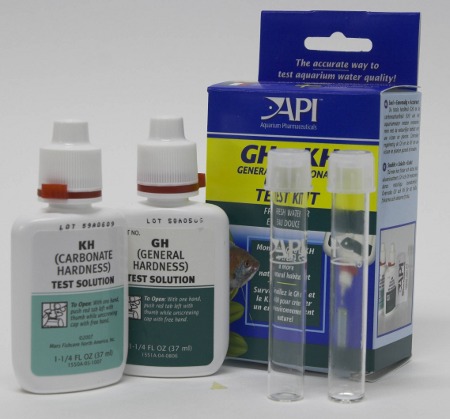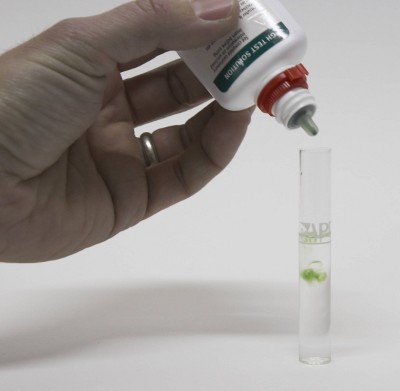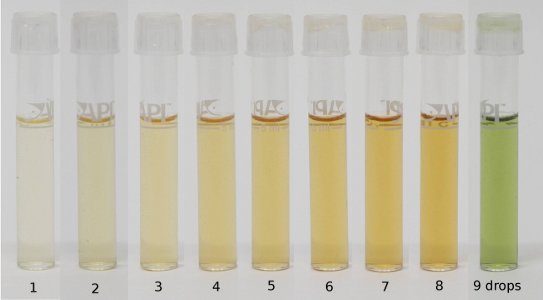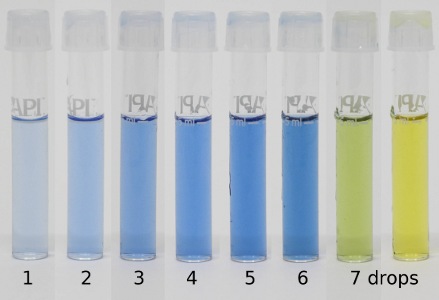From German brewing and more
|
|
| Line 13: |
Line 13: |
| | | | |
| | [[Image:Adding_titrant.jpg|frame|right|'''Figure 2''' - adding the titration solution to the water sample in the test tube one drop at a time]] | | [[Image:Adding_titrant.jpg|frame|right|'''Figure 2''' - adding the titration solution to the water sample in the test tube one drop at a time]] |
| | + | |
| | + | For the exact instructions how to use the test kit read the instruction that come with it. In particular how to convert the amount of titrant, that has been added, to a hardness value in dH or ppm as CaCO<sub>3</sub>. But in general they all work the same: |
| | + | |
| | + | * rinse the test tube with the water to be tested. |
| | + | * fill the test tube with a water same up to its marking. |
| | + | * add one drop of test solution, close the test tube and shake to mix water sample and test solution. |
| | + | * repeat this process until the color suddenly changes. |
| | + | * convert the number of drops that have been added to a hardness value using the instruction sheet. |
| | + | |
| | + | [[Image:GH_titration.jpg|frame|right|'''Figure 3''' - GH titration of a water sample. It took 9 drops until the color changed from blue to yellow. Thus the hardness of the water was about 9 dH or 160 ppm as CaCO<sub>3</sub>]] |
| | + | |
| | + | [[Image:KH_titration.jpg|frame|right|'''Figure 4''' - KH titration of the same water sample. It took 7 drops until the color changes from blue to green and later yellow. Thus the alkalinity of the water is 7 dH or 125 ppm as CaCO<sub>3</sub>]] |
| | + | |
| | + | |
| | + | |
| | + | |
| | | | |
| | | | |
| | |} | | |} |
Revision as of 04:22, 6 December 2009
|
Water composition is important for brewing and many brewers either send their water to a lab for analysis for build their water from scratch by using very soft (e.g. reverse osmosis water) and salts. It is, however, also possible to test brewing water at home. The precision and amount of detail of such a water test at home does not match that of a professional analysis, but it is sufficient to estimate the residual alkalinity of the brewing water with an acceptable precision. At home water testing also allows regular testing of the water source in order to detect seasonal changes that may warrant a more precise professional analysis.
 Figure 1 - A typical GH&KH test kit for aquarium use. It contains test tubes, test chemicals and instructions. The total price for kits like these is around $6 and while there are more expensive test kits available for fish owners they are useless to brewers since they test water parameters that aren't of interest for brewing. To do that water testing we brewers can use water test kits that are available for aquarium owners. The kind of test kit that we need is one that tests GH and KH. GH stands for General Hardness and measures the total hardness of the water. In water speak the total hardness is the amount of calcium and magnesium ions present. It is commonly measured as either dH (German Hardness) or ppm as CaCO3. Both these units are equivalent measures. That measns that they don't express the weight of the calcium and the magnesium ions but their number multiplied by their electrical charge. The latter is 2+ for both of them. With knowledge of the atomic weight and an guess on the calcium to magnesium ratio commonly found in water one can estimate the calcium and magnesium content of the analyzed water [DeLange].
KH stands for Karbonat Härte (German for carbonate hardness) which is the alkalinity of the water. Like total hardness or GH it is measured as either German Hardness (dH) or ppm as CaCO3. The conversion of 1 dH = 17.8 CaCO3 is true for both total hardness and alkalinity.
Two types test kits are available: titration based and strips. Titration based test kits contain test tubes and chemicals that are added until there is a color reaction in the water. Test strips are submersed in the water and the color reaction on their test pads is then compared against a color scale. While more difficult to use I prefer titration based tests since they provide more precise results are are easier to "read" than strips.
 Figure 2 - adding the titration solution to the water sample in the test tube one drop at a time For the exact instructions how to use the test kit read the instruction that come with it. In particular how to convert the amount of titrant, that has been added, to a hardness value in dH or ppm as CaCO3. But in general they all work the same:
- rinse the test tube with the water to be tested.
- fill the test tube with a water same up to its marking.
- add one drop of test solution, close the test tube and shake to mix water sample and test solution.
- repeat this process until the color suddenly changes.
- convert the number of drops that have been added to a hardness value using the instruction sheet.
 Figure 3 - GH titration of a water sample. It took 9 drops until the color changed from blue to yellow. Thus the hardness of the water was about 9 dH or 160 ppm as CaCO3  Figure 4 - KH titration of the same water sample. It took 7 drops until the color changes from blue to green and later yellow. Thus the alkalinity of the water is 7 dH or 125 ppm as CaCO3
|





